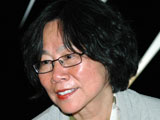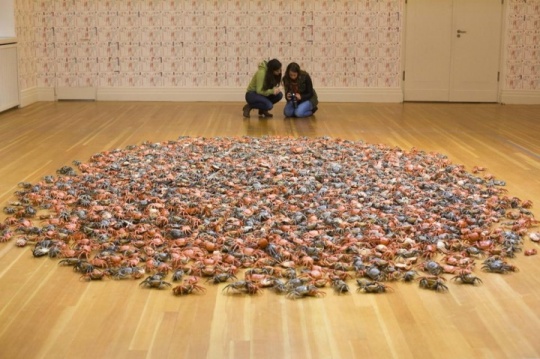Ai Weiwei’s Art and the Chinese Tragi-Comedy
by Tienchi Martin-Liao / July 23, 2014 / No comments
Thoughts on the artist’s one-man exhibition in Berlin.
The largest one-man exhibition of Ai Weiwei’s artwork ended this week in Berlin’s Martin-Gropius-Bau. During the past three months visitors have been impressed by his creative, bold, and indicative manner of artistic expression. The exhibition hall’s 3000 square meters housed 34 new pieces, several huge installations, photos, and videos that are the artist’s call for dialogue and mutual understanding between himself and the viewers. Throughout the exhibit one can feel the artist’s tension and explosive strength, even though he was absent from the proceedings.

- During the Cultural Revolution, people were sentenced to death or outright murdered because of one wrong sentence. In China today writers do not lose their lives over their poems or articles; however, they are jailed for years. My friend Liu Xiaobo for example will stay in prison till 2020; even winning the Nobel Peace Prize could not help him. In prison those lucky enough not to be sentenced to hard labor play “blind chess” to kill time AND TO TRAIN THE BRAIN NOT TO RUST. Freedom of expression is still a luxury in China. The firewall is everywhere, yet words can fly above it and so can our thoughts. My column, like the blind chess played by prisoners, is an exercise to keep our brains from rusting and the situation in China from indifference.

- Tienchi Martin-Liao is the president of the Independent Chinese PEN Center. Previously she worked at the Institute for Asian Affairs in Hamburg, Germany, and lectured at the Ruhr-University Bochum from 1985 to 1991. She became head of the Richard-Wilhelm Research Center for Translation in 1991 until she took a job in 2001 as director of the Laogai Research Foundation (LRF) to work on human rights issues. She was at LRF until 2009. Martin-Liao has served as deputy director of the affiliated China Information Center and was responsible for updating the Laogai Handbook and working on the Black Series, autobiographies of Chinese political prisoners and other human rights books. She was elected president of the Independent Chinese PEN Center in October 2009 and has daily contact with online journalists in China.
Though Ai is not in jail, he cannot leave China and come to his own exhibition. He can move “freely,” yet he’s always under surveillance and tailed by a bunch of police. However, the government’s pressure and suppression seems to be one of the most important sources of ideas and emotional inspiration for him. Without “big brother” watching, threatening, harassing, and conducting sabotage Ai would probably only be half as good, and half as successful. Really, the story of Ai Weiwei and his fight sounds like a paranoid tragic-comedy.
The problem with contemporary art is that most artists are trying to see things from a twisted new perspective, and record it in an absurd, sensational form. It infrequently imparts any outstanding thoughts nor ideas. No wonder this kind of art generates no resonance among its viewers. However, Ai is different. He is a great artist who knows how to reproduce the anxiety, humiliation, anger, and fear he suffers daily as a dissident-artist and he knows how to use his work to transfer these genuine feelings and complex circumstances to viewers.
The title of his Berlin exhibition is “Evidence.” Showing evidence not in court but in a museum, through aesthetic artworks one can trace back to the thoughts of the artist. In this, Ai has picked up prominent political and social topics from Chinese society and presented them in a provocative and humorous way. For example, hundreds of porcelain river crabs (hexie) piled on the ground coincide with the Beijing government’s hypocritical slogan of “social harmony” (hexie). In fact, in November 2010 Ai invited hundreds of neighbors to his Shanghai workshop for a “crab-eating party,” but, because of police intervention, the party certainly didn’t take place under harmonious circumstances.
A year after the earthquake in Sichuan, where nearly 70,000 thousand people died, a large part of them school children, Ai hosted an exhibition in Munich where 8,738 school bags were hung to symbolize and memorialize the number of students who were killed in the earthquake. Before the exhibition, Ai went to the site of the catastrophe in Chengdu, where he helped victims and gathered materials. While he was there, he was taken to a police station and beaten up by several policemen. With a head wound he still flew to Munich for the opening of his exhibition. If the German physicians had delayed performing the surgery Ai could’ve died of of a brain hemorrhage.
There is hardly a piece of Ai’s work that doesn’t contain an allusion to Chinese reality, historical or contemporary. When he made a series of photos of himself dropping a 2000 year-old Han vase, the effect and value of this act far outweighed the object itself. Breaking with tradition is painful but also means courage and decisiveness. Ai’s reconstruction of the prison cell where he was kept for 81 days need no further comment. This year six thousand old wooden stools filled the courtyard of the Martin-Gropius-Bau. The view leaves lots of room for the imagination and is indicative of Ai, who moves between traditional and modern, between East and West, between individual and state. With his conceptual art he tries to generate a brain-storm with the viewers to confront China and art, and to readjust their understanding of China and their habitual appraisal of art. As an artist who spent his youth and early adulthood in cultural revolutional China and who lived in the artistic and proletarian milieu of New York for years, his life has been nourished with rich multicultural elements. In his art, between realism and surrealism, one can find the touches of Marcel Duchamp or Andy Warhol. Ai’s work represents peaceful resistance against totalitarianism and all kinds of censorship and state control. With his work, behavior, and actions he shows the world that there are multiple methods of protecting one’s rights and dignity.
“Isn’t it dangerous,” he was once asked by the media, “to always stand at the front of protests?”
His response was, “If I do it alone, it is dangerous; if there is a second one who speaks out [the truth], then my danger will be shared by him/her. If one hundred people do the same, then the threat for me is only one percent.”
Like a magnet, Ai exudes waves of enthusiasm and people around the world move to support his political-artistic action. When the authority claimed that his nude photograph with five women promoted pornography, people posted their naked pictures on the internet in solidarity. When he was behind bars, people started the “Who’s Afraid of Ai Weiwei” and the “chair protest” street art campaigns.
All roads lead to Rome. When people in different regions of the world are struggling desperately for their freedom, they should know that violence is not the only way to achieve the goal. Ai Weiwei shows us that fresh ideas, creativity, irony—or self-irony—are better weapons in the fight for justice and liberty.





